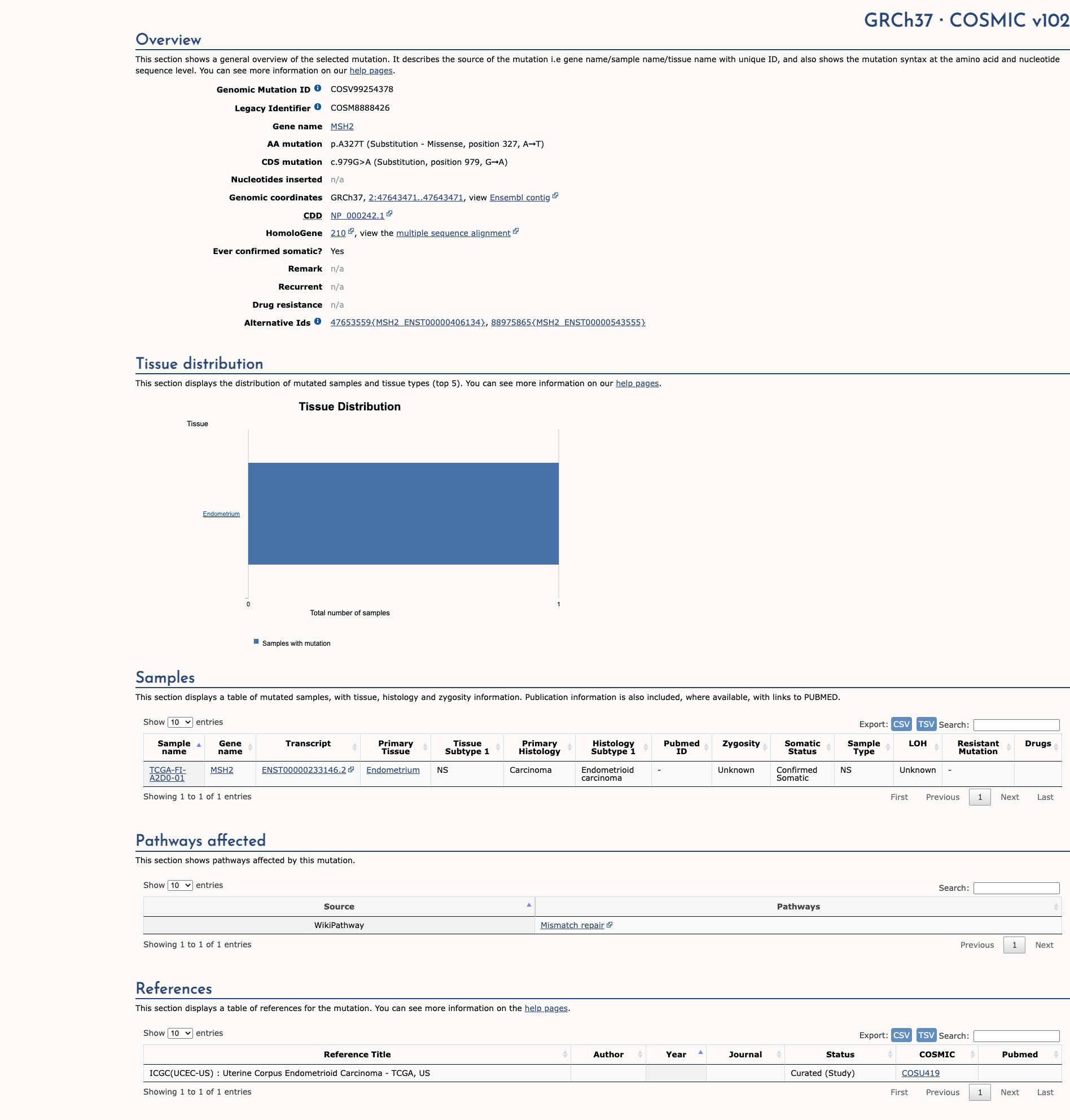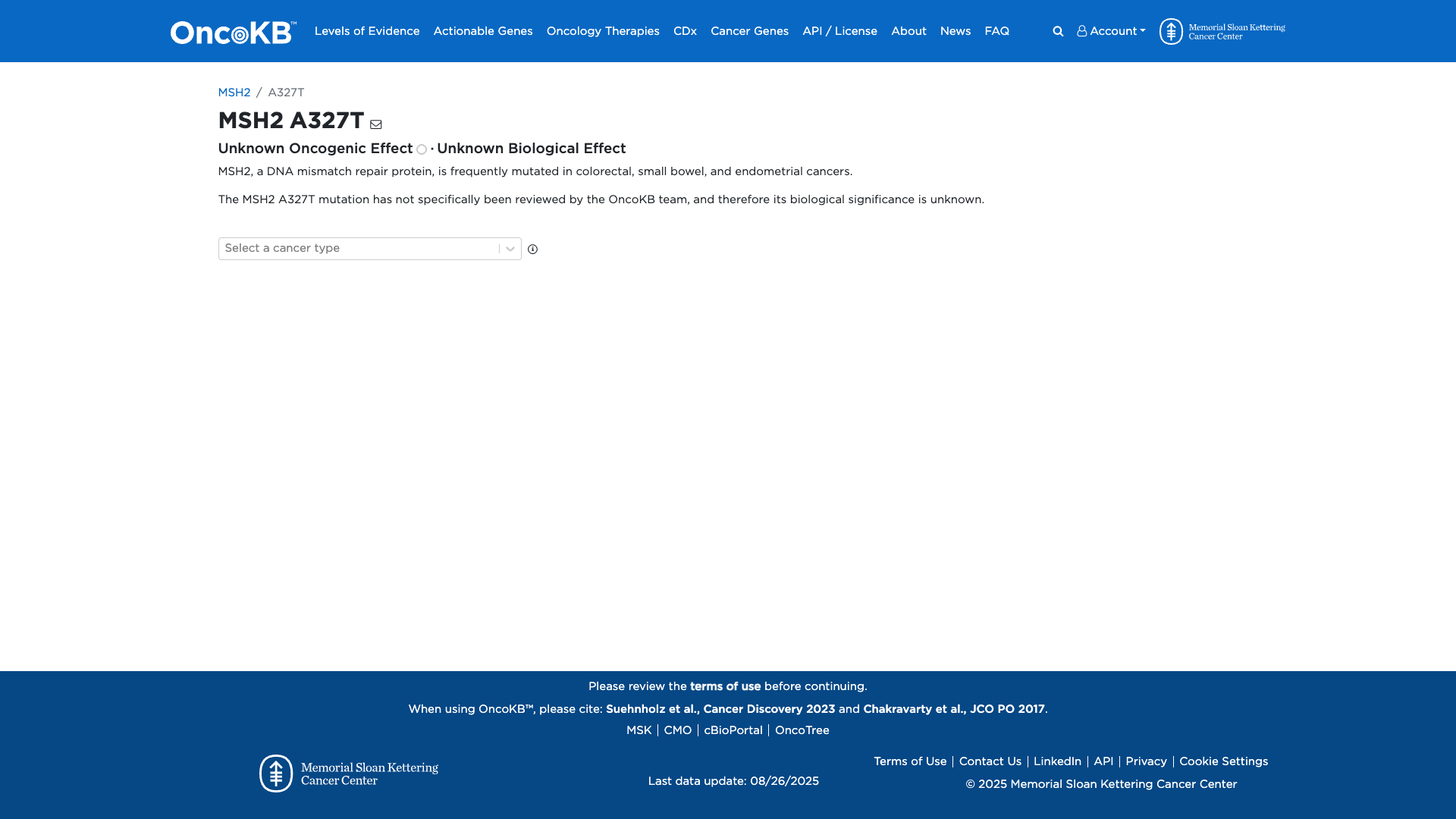MSH2 c.979G>A, p.Ala327Thr
NM_000251.2:c.979G>A
COSMIC ID: COSM8888426
Variant of Uncertain Significance (VUS)
This MSH2 p.Ala327Thr variant is absent from population databases (PM2_Supporting) and computational/splicing predictions are benign (BP4_Supporting). No other supporting or conflicting data are available. The combined evidence yields a Variant of Uncertain Significance.
ACMG/AMP Criteria Applied
PM2
BP4
Genetic Information
Gene & Transcript Details
Gene
MSH2
Transcript
NM_000251.3
MANE Select
Total Exons
16
Strand
Forward (+)
Reference Sequence
NC_000002.11
Alternative Transcripts
| ID | Status | Details |
|---|---|---|
| NM_000251.2 | RefSeq Select | 16 exons | Forward |
| NM_000251.1 | Alternative | 16 exons | Forward |
Variant Details
HGVS Notation
NM_000251.2:c.979G>A
Protein Change
A327T
Location
Exon 6
(Exon 6 of 16)
5'Exon Structure (16 total)3'
Functional Consequence
Loss of Function
Related Variants
ClinVar reports other pathogenic variants at position 327: A327V
Alternate Identifiers
COSM8888426
Variant interpretation based on transcript NM_000251.3
Genome Browser
Loading genome browser...
HGVS InputNM_000251:c.979G>A
Active Tracks
ConservationRefSeqClinVargnomAD
Navigation tips: Use mouse to drag and zoom. Click on features for details.
Clinical Data
Population Frequency
Global Frequency
0.0 in 100,000
Extremely Rare
Global: 0.0%
0%
0.05%
0.1%
1%
5%
10%+
ACMG Criteria Applied
PM2
This variant is not present in gnomAD (PM2 criteria applies).
Classification
Uncertain Significance (VUS)
Based on 3 submitter reviews in ClinVar
Submitter Breakdown
3 VUS
Pathogenic
Likely Path.
VUS
Likely Benign
Benign
Publications (0)
No publication details.
Clinical Statement
This variant has been reported in ClinVar as Uncertain significance (3 clinical laboratories).
Functional Impact
Functional Domain
Hotspot Status
Not a hotspot
Domain Summary
This variant is not located in a mutational hotspot or critical domain (0 mutations).
Related Variants in This Domain
ClinVar reports other pathogenic variants at position 327: A327V
PM5 criterion applied.
Computational Analysis
Pathogenicity Predictions
REVEL Score
0.513
0.513
Likely Benign0.0
Uncertain (Low)0.2
Uncertain (Med)0.5
Likely Pathogenic0.75
REVEL scores ≥ 0.75 are strong evidence (PP3)
Predictor Consensus
Mixed/VUS
PP3 Applied
No
Additional Predictors
Pathogenic:
metalr: D
Benign:
CADD: 3.04polyphen_prediction: benignmetasvm: Tprimateai: T
Neutral: Show all
VCEP Guidelines
Applied ACMG/AMP Criteria (VCEP Specific) VCEP Guidelines
PVS1
PVS1 (Not Applied) Strength Modified
According to VCEP guidelines, the rule for PVS1 is: “Very Strong Nonsense/frameshift variant introducing Premature Termination Codon ≤ codon 891 in MSH2...”. The evidence for this variant shows: it is a missense change (p.Ala327Thr), not a null variant. Therefore, this criterion is not applied.
PS1
PS1 (Not Applied) Strength Modified
According to VCEP guidelines, the rule for PS1 is: “A predicted missense substitution that encodes the same amino acid change with a different underlying nucleotide change previously established by this VCEP as Pathogenic”. The evidence for this variant shows: no previously established pathogenic variant causes p.Ala327Thr by any nucleotide change. Therefore, this criterion is not applied.
PS2
PS2 (Not Applied) Strength Modified
According to VCEP guidelines, the rule for PS2 is: “Very Strong ≥4 de novo points; Strong 2–3 de novo points; Moderate 1 de novo point; Supporting 0.5 de novo points”. The evidence for this variant shows: no de novo data available. Therefore, this criterion is not applied.
PS3
PS3 (Not Applied) Strength Modified
According to standard ACMG guidelines, the rule for PS3 is: “Strong: well-established functional studies supportive of a damaging effect; Moderate/Supporting as calibrated functional assays”. The evidence for this variant shows: no functional studies have been performed. Therefore, this criterion is not applied.
PS4
PS4 (Not Applied) Strength Modified
According to standard ACMG guidelines, the rule for PS4 is: “Prevalence in affected individuals statistically increased over controls”. The evidence for this variant shows: no case-control or statistical data. Therefore, this criterion is not applied.
PM1
PM1 (Not Applied) Strength Modified
According to standard ACMG guidelines, the rule for PM1 is: “Located in a mutational hot spot and/or critical and well-established functional domain without benign variation”. The evidence for this variant shows: p.Ala327 is not in a recognized mutational hotspot or critical functional domain. Therefore, this criterion is not applied.
PM2
PM2 (Supporting) Strength Modified
According to VCEP guidelines, the rule for PM2 is: “Supporting Absent/extremely rare (<1 in 50,000 alleles) in gnomAD v4 dataset”. The evidence for this variant shows: variant not found in population databases (gnomAD). Therefore, this criterion is applied at Supporting strength because the variant is absent from controls.
PM3
PM3 (Not Applied) Strength Modified
According to VCEP guidelines, the rule for PM3 is: “Evidence of pathogenic variant in trans for recessive disorders with point assignment”. The evidence for this variant shows: no data on trans configuration with another pathogenic MSH2 variant. Therefore, this criterion is not applied.
PM4
PM4 (Not Applied) Strength Modified
According to standard ACMG guidelines, the rule for PM4 is: “Protein length changes as a result of in-frame deletions/insertions in a non-repeat region or stop-loss variants”. The evidence for this variant shows: this is a missense change without protein length alteration. Therefore, this criterion is not applied.
PM5
PM5 (Not Applied) Strength Modified
According to VCEP guidelines, the rule for PM5 is: “Moderate: missense change at a residue where a different missense change was classified as Pathogenic by this VCEP, only if PP3 is supporting”. The evidence for this variant shows: PP3 is not applied and no confirmed different pathogenic missense at p.Ala327. Therefore, this criterion is not applied.
PM6
PM6 (Not Applied) Strength Modified
According to standard ACMG guidelines, the rule for PM6 is: “Assumed de novo, without confirmation of paternity and maternity”. The evidence for this variant shows: no de novo information. Therefore, this criterion is not applied.
PP1
PP1 (Not Applied) Strength Modified
According to VCEP guidelines, the rule for PP1 is: “Supporting/Moderate/Strong co-segregation with disease in multiple affected family members”. The evidence for this variant shows: no segregation data available. Therefore, this criterion is not applied.
PP2
PP2 (Not Applied) Strength Modified
According to standard ACMG guidelines, the rule for PP2 is: “Missense variant in a gene with a low rate of benign missense variation and where missense is a common mechanism of disease”. The evidence for this variant shows: MSH2 has numerous reported pathogenic and benign missense variants. Therefore, this criterion is not applied.
PP3
PP3 (Not Applied) Strength Modified
According to VCEP guidelines, the rule for PP3 is: “Supporting missense variant with HCI prior probability >0.68 or SpliceAI ≥0.2”. The evidence for this variant shows: mixed in silico results, SpliceAI predicts no splicing impact (delta score 0). Therefore, this criterion is not applied.
PP4
PP4 (Not Applied) Strength Modified
According to VCEP guidelines, the rule for PP4 is: “Supporting: 1 CRC/Endometrial MSI-H tumor with consistent loss of MMR protein expression”. The evidence for this variant shows: no tumor phenotype or MSI/MMR IHC data. Therefore, this criterion is not applied.
PP5
PP5 (Not Applied) Strength Modified
According to standard ACMG guidelines, the rule for PP5 is: “Reputable source reports variant as pathogenic without available evidence”. The evidence for this variant shows: ClinVar reports Uncertain Significance only. Therefore, this criterion is not applied.
BA1
BA1 (Not Applied) Strength Modified
According to VCEP guidelines, the rule for BA1 is: “Stand Alone: gnomAD v4 Grpmax filtering allele frequency ≥0.001 (0.1%)”. The evidence for this variant shows: allele frequency is 0%. Therefore, this criterion is not applied.
BS1
BS1 (Not Applied) Strength Modified
According to VCEP guidelines, the rule for BS1 is: “Strong: gnomAD v4 Grpmax filtering allele frequency ≥0.0001 and <0.001”. The evidence for this variant shows: allele frequency is 0%. Therefore, this criterion is not applied.
BS2
BS2 (Not Applied) Strength Modified
According to VCEP guidelines, the rule for BS2 is: “Strong: co-occurrence in trans with known pathogenic variant in a healthy individual”. The evidence for this variant shows: no such observations. Therefore, this criterion is not applied.
BS3
BS3 (Not Applied) Strength Modified
According to VCEP guidelines, the rule for BS3 is: “Strong: functional assays show no damaging effect; Supporting: calibrated assays with odds ≤0.48”. The evidence for this variant shows: no functional data. Therefore, this criterion is not applied.
BS4
BS4 (Not Applied) Strength Modified
According to VCEP guidelines, the rule for BS4 is: “Strong/Supporting lack of segregation with disease”. The evidence for this variant shows: no segregation data. Therefore, this criterion is not applied.
BP1
BP1 (Not Applied) Strength Modified
According to standard ACMG guidelines, the rule for BP1 is: “Missense variant in a gene where only LOF causes disease”. The evidence for this variant shows: missense is an established disease mechanism in MSH2. Therefore, this criterion is not applied.
BP2
BP2 (Not Applied) Strength Modified
According to standard ACMG guidelines, the rule for BP2 is: “Observed in trans with a pathogenic variant for a fully penetrant dominant gene”. The evidence for this variant shows: no such data. Therefore, this criterion is not applied.
BP3
BP3 (Not Applied) Strength Modified
According to standard ACMG guidelines, the rule for BP3 is: “In-frame deletions/insertions in repetitive regions without a known functional role”. The evidence for this variant shows: this is a missense variant. Therefore, this criterion is not applied.
BP4
BP4 (Supporting)
According to VCEP guidelines, the rule for BP4 is: “Supporting: missense variant with HCI-prior probability <0.11 OR SpliceAI predicts no splicing impact with delta score ≤0.1”. The evidence for this variant shows: SpliceAI delta score = 0, and overall computational tools are discordant with a trend toward benign. Therefore, this criterion is applied at Supporting strength because in silico evidence suggests no impact.
BP5
BP5 (Not Applied) Strength Modified
According to VCEP guidelines, the rule for BP5 is: “Supporting: multiple unrelated tumors lacking MSI-H or MMR loss inconsistent with variant gene”. The evidence for this variant shows: no tumor data. Therefore, this criterion is not applied.
BP6
BP6 (Not Applied) Strength Modified
According to standard ACMG guidelines, the rule for BP6 is: “Reputable source reports variant as benign without provided evidence”. The evidence for this variant shows: no such reports. Therefore, this criterion is not applied.
BP7
BP7 (Not Applied) Strength Modified
According to standard ACMG guidelines, the rule for BP7 is: “Synonymous variant with no predicted splice impact at or beyond -21/+7”. The evidence for this variant shows: this is a missense substitution. Therefore, this criterion is not applied.



